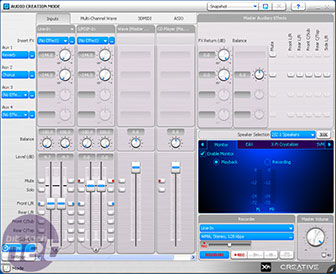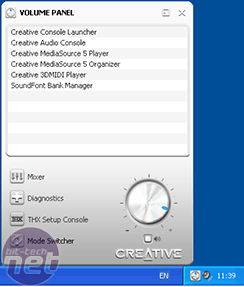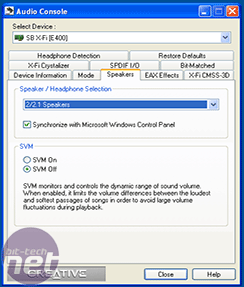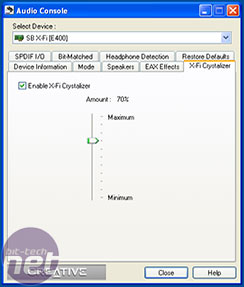
Installation:
After popping in the CD, the installation procedure is started with an annoying unavoidable and full screen "X-Fi" flash video. Creative also did this with the Audigy series before, and it's still incredibly frustrating.The subsequent installation procedure is not bad though, with the default option being "drivers only" for maximum performance, although there are many extra programs you can choose from (and come back to install later) if you want them.
After the installation and reboot, the software runs an auto-update feature which mat not be absolutely necessary, but it certainly is extremely helpful to keep people as up to date as possible.
Software:
The Creative Audio console lets you tweak the settings and is the place to select between the major modes, Entertainment, Game and Audio Creation, supported by the card. In Windows XP there is a task bar icon and a quick way of selecting between the modes but in Vista that is yet to materialise.
The XP software version is built around a Hi-Fi gimmick which may or may not suit some. As good as it looks, we'd personally prefer the option of a very simple, obvious and minimal interface, not that the software takes any significant time to load though.
The X-Fi Crystalizer is a hardware up-sampling engine that converts the audio into a 24-bit stream that claims to improve the fidelity. Some audio purists will argue that any sort of post-processing like this, adding information where it never was, will do little to give you proper sound. However, having used it on several Creative X-Fi cards now it certainly does something positive in nearly all scenarios. The advantage is that you can adjust it to tailor it to work exactly at the percentage the sound requires to suit you, rather than just having it as an "on" or "off" setting.
CMSS-3D is an audio expanding engine that separates stereo or simple multichannel audio into more virtual channels, so if you have basic headphones, a set of stereo speakers or anything up to 5.1 audio, you can experience a virtual 7.1 surround.
In addition there's also Smart Volume Management, or SVM, that monitor the dynamic range of the audio and adjusts the sound volume accordingly, this way you won't get huge differences between massive explosions and quiet whispers in movies for example. It's particularly useful for headphone users who don't enjoy the occasionally sudden scramble to rip the cans off your lugs before you pop a drum.
Finally, Creative also includes a range of (questionably useful) EAX effects that offer different environmental presets which can change your sound if you enjoy thinking you're sitting listening in an Amphitheatre for example. I don't know anyone who ever actively uses these effects, other than using them for a short lived novelty.
Windows Vista?
Creative has a certain notoriety in its driver support and Windows Vista offered (like many other companies) a little bit of a headache, as Microsoft dropped the HAL (hardware abstraction layer) which included DirectSound and DirectSound3D. Creative's EAX had previously been built on this in many Windows OS previous.To many, this was a dramatic improvement as the HAL often increased sound latency to unacceptable levels (partly why ASIO was invented) and also made it very specific to Windows OSes. This was superseded by OpenAL, a cross-platform 3D audio API which can be used for a variety of audio applications. It was native to the Xbox and is also native to the Xbox 360 (so we now know why Microsoft wanted to push it to Vista), as well as certain Linux distros like BSD and Solaris.
OpenAL (Open Audio Layer) is the audio equivalent to OpenGL and has recently been updated to version 1.1. Creative is a major player behind OpenAL and despite being "open source", Creative still holds licences within it. The 1.1 SDK for example can be downloaded from Creative itself.
The Creative X-Fi has native OpenAL support, but some older cards don't; this can lead to some Vista driver frustration. Some older games also cannot support EAX and other audio techniques in OpenAL, which is why Creative has its Alchemy project. The Alchemy engine reinitiates the audio effects like EAX and DS3D in Vista to give multichannel sound with hardware effects within the game rather than just plain old stereo sound. That's the whole reason we buy soundcards, right?

MSI MPG Velox 100R Chassis Review
October 14 2021 | 15:04













Want to comment? Please log in.